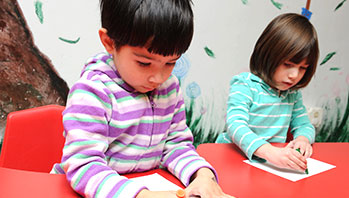- chart paper
- crayons
- markers
- squares of paper
- pictures (yellow objects)
MA Standards:
Foundational Skills/RF.PK.MA.1: With guidance and support, demonstrate understanding of the organization and basic features of printed and written text: books, words, letters, and the alphabet.
Head Start Outcomes:
Language Development/Receptive Language: Attends to language during conversations, songs, stories, or other learning experiences.
Literacy Knowledge/Phonological Awareness: Identifies and discriminates between words in language.
Literacy Knowledge/Print Concepts and Conventions: Understands conventions, such as print moves from left to right and top to bottom of a page.
PreK Learning Guidelines:
English Language Arts/Language 3: Communicate personal experiences or interests.
English Language Arts/Reading and Literature 7: Develop familiarity with the forms of alphabet letters, awareness of print, and letter forms.
Draw and Write Together: Poems and Pictures

© Commonwealth of Massachusetts, Department of Early Education and Care (Jennifer Waddell photographer). All rights reserved.
STEM Key Concepts: There are many different colors
ELA Focus Skills: Concepts of Print, Listening and Speaking, Vocabulary, Writing
Read the poem “Yellow” by Barbara Juster Esbensen. Review the things that are yellow.
- Explain that an author uses words in a poem to “paint” pictures in our minds, or help us think about the words as pictures.
- Say, The words of a poem can help a reader see, hear, smell, or feel something. How would you describe yellow? Let’s write a poem together describing yellow. Let’s try to help someone imagine what yellow looks like, sounds like smells like, and feels like.
Write the lines below on chart paper and read them aloud. Have each child add line to the poem. If children have difficulty thinking of a yellow object, encourage them to look at the pile of pictures.
What is Yellow?
Yellow is a pineapple with bumpy skin.
Yellow is a pucker lemon in my lemonade.
Yellow is a squishy ball bouncing.
Yellow is a .
Read the finished poem aloud and track the words as you read. You may want to invite volunteers to track lines from right to left.
- Then give each child a paper square and have them draw a picture of the object they added to the poem.
- Invite children to tape their completed picture next to the line in the poem.
- Display the poem chart in the room for children to revisit and read together.
Adaptation: If younger children have difficulty putting their description into words, have them draw something that is yellow instead. Then help them find words to describe the drawing.
